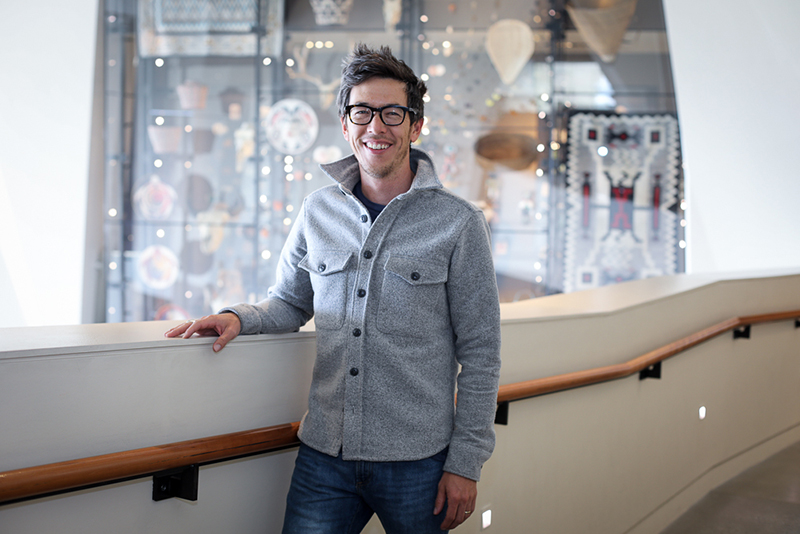
Man of the Museum: Tim Lee of the Natural History Museum of Utah
Art
The clean, simplistic exhibits in the Natural History Museum of Utah highlight the vast collection that the museum has to offer, with everything from dinosaur fossils to delicate butterfly samples. Behind the scenes is Exhibits Manager & Senior Exhibit Designer Tim Lee, who has been designing exhibits for the NHMU for 14 years, in what Lee refers to as “storytelling through space.” Even at the entryway to the museum, there is an eye-catching collection wall of over 600 objects and artifacts, hung carefully in a multi-story glass case. The cascade of colors—the brightly colored butterfly wings and small amphibian specimens, among other artifacts—greets visitors from both sides and is Lee’s own design. “I try to make the objects the stars and the stories at the center of every experience,” he says.
Having attended art school in Milan, Italy, as well as possessing a design background before coming into his role at NHMU, Lee is inspired by the storytelling aspect of designing for a space. “Storytelling is one of the most ancient things that humans do,” he says. “It connects us. It’s what makes us human. I’ve always loved that. To figure out that I could do it three-dimensionally … I couldn’t imagine anything better than that.” Lee’s design process includes coming up with a concept with the help of scientists, researchers and sometimes other artists, and then looking to the museum’s collection to see which objects will help tell that story. Lee then designs how the object will be displayed, down to the lighting, keeping in line with how to best preserve the artifact in question. The flow of the NHMU resonates with that ever-evolving storyline, and Lee’s designs help breathe life into the 1.6 million artifacts in the museum’s collections. “The majority of our objects, even though we do have some from around the world, they’re from Utah,” he says. “That for me is the soul of our institution, our collections.”
The process for coming up with an exhibit to highlight these collections can take up to three years to plan, with Lee and his team currently working on a “blockbuster” exhibit slated for debut in October 2019. During this process, Lee works with researchers for the information and then filters the research into something interactive and appealing for museum visitors. “I try to take science, divide it into stories and then align those stories with different ways to deliver them,” he says. “I try to create a lot of variation in those ways we deliver them. That’s the thing that fuels me—constantly investigating the best way to engage [the] visitor.”
Obviously, the gargantuan dinosaur exhibit or the beautiful Navajo artifacts on display are visually appealing, but some of the genius comes in the way that the museum provides stations where you can smell certain plants, hear the words of Utah’s native people or interact with diagrams featuring the ecosystems in the Salt Lake Valley. One interactive experience at the NHMU that Lee is particularly fond of is one he created to depict the way plants interlock pollutants to help purify groundwater. The interaction is based on a Japanese pachinko arcade that Lee’s father had once possessed and is just one example of how the museum can appeal to any burgeoning scientist. For Lee, engaging all five senses within an exhibit creates an entry point for people of any background to explore science and understand the story that Lee is relaying. “I’m more interested in inspiring people to ask certain questions and to present science as sort of this open-ended, evolving story that we can all be a part of, whether you’re a scientist, an artist, a writer or a musician,” he says. “Science is for all of us.”
For Lee, the most rewarding and challenging aspects of designing for the NHMU is creating a connection between the various researchers and the museum visitor without losing any of the integrity of the research involved. “Earning a scientist’s trust to hold their knowledge and present it in the way that you think will be most accessible—that’s one of the biggest obstacles,” he says. This includes updating displays to keep up with the rapidly developing research and editing displays that do not engage the visitor as intended on an almost daily basis. To Lee, the constant changes in the world of science are the most exciting thing about his job and about science in general, though he credits his “day-to-day survival mentality” in being able to keep up and keep his designs relevant and fresh for museum visitors. Some of the changes slated to take place in the NHMU’s near future are the addition of new species to the dinosaur fossils in the “Past Worlds” exhibit, as well as updating the “Utah Futures” exhibit, which Lee says is always a work in progress.
As a local Utahn, Lee’s philosophy of incorporating the NHMU’s pieces into an interlocking story of the history of Utah is something he shares with the museum itself, which has always remained Utah-centric and celebrated the history and natural beauty of our state. “That’s my commitment to the community,” he says. “I love Salt Lake. I definitely feel like I’ve been nurtured within this community. I feel like it’s such an exciting time to be here.”
Editor’s note: The first version of this article indicated that the Natural History Museum of Utah houses thousands of artifacts in its collections, which we’ve amended to 1.6 million. Additionally, the previous version said “dinosaur bones” in the fifth paragraph, which has been updated to “dinosaur fossils,” as it is the correct distinction. We’ve also revised the same sentence with regard to the dinosaur fossils’ exhibit, “Past Worlds,” which reflects the biodiversity in said exhibit.